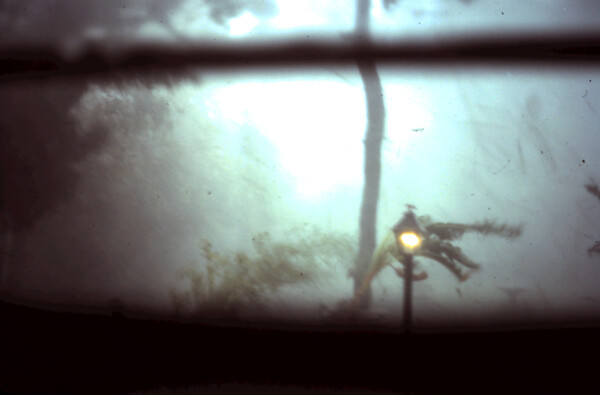Hurricane season is about to become active. Are NOAA and FEMA up to the challenge?

This was the scene on Sept. 23, 1973, as Hurricane Eloise struck the Florida panhandle. This photo was taken by my father, Del Stone Sr., from the kitchen window of our house in Fort Walton Beach.
We are entering the heart of hurricane season. Statistically, August and September are the months most likely to see tropical cyclone formation.
And we still don’t know if the various weather-forecasting services are going to be up to the job.
That’s because the National Oceanic and Atmospheric Administration, which is the parent organization of the National Hurricane Center and the National Weather Service, suffered significant staff reductions as a result of DOGE cuts.
I was not able to determine how many weather forecasters lost their jobs, but yes, meteorologists were among those who were let go, along with people who fly into hurricanes to take direct measurements from the storm, people who run the weather models to predict a storm’s future path, people who monitor data coming in from remote sensing platforms like satellites, buoys and weather balloons, radar technicians, and other people with mission-critical responsibilities.
What a lot of people don’t understand is the National Hurricane Center must coordinate with local offices of the National Weather Service to make sure people in the path of a landfalling hurricane have the latest information about the storm. NHC figures where the storm is, where it’s going, when it will hit and how strong it will be. NWS figures out what the local effects will be and warns people about the threat. We’ve seen how important that can be when, earlier this year, floods struck Texas, causing massive loss of life.
Also what remains to be seen is how, and if, FEMA responds to a natural disaster like a hurricane. That’s because FEMA also suffered cutbacks, and was compelled to spend about a billion dollars building an immigrant detention facility in the Everglades, the infamous “Alligator Alcatraz.”
So there are lots of unanswered questions as we enter this busy part of the hurricane season, and I think the inescapable conclusion any reasonable-minded person could draw from our current situation is that this regime does not care about people. It cares about money. Because if you took the money we taxpayers spend on ONE golf trip by the president to the state of Florida, we could probably rehire all of those forecasters.
That’s where their priorities lie – in golf trips and tax breaks for billionaires, not us taxpayers struggling to get by in a system rigged to favor rich white men and mega-corporations.
Tells you a lot about their character, doesn’t it?
About the author:
Del Stone Jr. is a professional fiction writer. He is known primarily for his work in the contemporary dark fiction field, but has also published science fiction and contemporary fantasy. Stone’s stories, poetry and scripts have appeared in publications such as Amazing Stories, Eldritch Tales, and Bantam-Spectra’s Full Spectrum. His short fiction has been published in The Year’s Best Horror Stories XXII; Alfred Hitchcock’s Mystery Magazine; the Pocket Books anthology More Phobias; the Barnes & Noble anthologies 100 Wicked Little Witch Stories, Horrors! 365 Scary Stories, and 100 Astounding Little Alien Stories; the HWA anthology Psychos; and other short fiction venues, like Blood Muse, Live Without a Net, Zombiesque and Sex Macabre. Stone’s comic book debut was in the Clive Barker series of books, Hellraiser, published by Marvel/Epic and reprinted in The Best of Hellraiser anthology. He has also published stories in Penthouse Comix, and worked with artist Dave Dorman on many projects, including the illustrated novella “Roadkill,” a short story for the Andrew Vachss anthology Underground from Dark Horse, an ashcan titled “December” for Hero Illustrated, and several of Dorman’s Wasted Lands novellas and comics, such as Rail from Image and “The Uninvited.” Stone’s novel, Dead Heat, won the 1996 International Horror Guild’s award for best first novel and was a runner-up for the Bram Stoker Award. Stone has also been a finalist for the IHG award for short fiction, the British Fantasy Award for best novella, and a semifinalist for the Nebula and Writers of the Future awards. His stories have appeared in anthologies that have won the Bram Stoker Award and the World Fantasy Award. Two of his works were optioned for film, the novella “Black Tide” and short story “Crisis Line.”
Stone recently retired after a 41-year career in journalism. He won numerous awards for his work, and in 1986 was named Florida’s best columnist in his circulation division by the Florida Society of Newspaper Editors. In 2001 he received an honorable mention from the National Lesbian and Gay Journalists Association for his essay “When Freedom of Speech Ends” and in 2003 he was voted Best of the Best in the category of columnists by Emerald Coast Magazine. He participated in book signings and awareness campaigns, and was a guest on local television and radio programs.
As an addendum, Stone is single, kills tomatoes and morning glories with ruthless efficiency, once tied the stem of a cocktail cherry in a knot with his tongue, and carries a permanent scar on his chest after having been shot with a paintball gun. He’s in his 60s as of this writing but doesn’t look a day over 94.
Contact Del at [email protected]. He is also on Facebook, twitter, Pinterest, tumblr, TikTok, and Instagram. Visit his website at delstonejr.com .
![]()
Leave a Reply